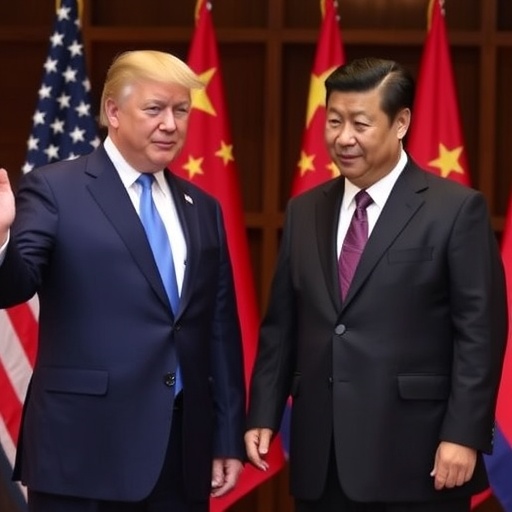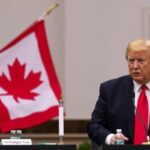Trump-Xi Meeting at APEC Summit in South Korea: Will This Face-Off End the Escalating Trade War?
In a high-stakes diplomatic maneuver, President Donald Trump is set to engage in direct talks with Chinese President Xi Jinping at the upcoming APEC summit in South Korea, aiming to cool the flames of the intensifying trade war that has rattled global economies. This Trump Xi meeting, announced amid mounting pressures from soaring tariffs and supply chain disruptions, represents a pivotal moment that could either pave the way for deescalation or deepen the rift between the world’s two largest economies.
- The High Stakes of the Trump Xi meeting Amid Tariff Tensions
- A Timeline of Escalation: From Initial Tariffs to Full-Blown Trade War
- South Korea’s Strategic Pivot: Hosting the APEC Summit as Trade War Mediator
- Global Markets Brace for Outcomes: Expert Insights on China Tariffs and Beyond
- Looking Ahead: Pathways to Deescalation and Lingering Risks in US-China Ties
The announcement comes just weeks after the latest round of China tariffs imposed by the U.S., which targeted over $300 billion in Chinese imports, prompting retaliatory measures from Beijing that hit American agricultural exports hard. With markets volatile and businesses pleading for relief, the summit in South Korea offers a rare neutral venue for leaders to hash out differences face-to-face, away from the tweet storms and proxy battles that have defined the conflict so far.
The High Stakes of the Trump Xi meeting Amid Tariff Tensions
The Trump Xi meeting at the APEC summit is more than a bilateral chat; it’s a potential turning point in a trade war that has already cost the global economy an estimated $1.7 trillion in lost output since its inception in 2018, according to a recent report from the International Monetary Fund (IMF). As leaders converge on Busan, South Korea, the eyes of the world will be on whether these talks can yield concrete concessions on issues like intellectual property theft, forced technology transfers, and unbalanced trade practices—core grievances fueling the U.S. administration’s aggressive stance.
Trump, known for his deal-making bravado, has repeatedly touted his personal rapport with Xi as a key asset. In a recent interview with Fox News, he stated, “Xi and I get along great; we’ve done tremendous deals before, and we’ll do it again. This trade war ends when China plays fair.” Yet, sources close to the White House indicate that expectations are tempered, with U.S. Trade Representative Robert Lighthizer preparing a tough negotiating brief that includes demands for verifiable reforms rather than vague promises.
On the Chinese side, Xi’s delegation arrives with its own arsenal of arguments, emphasizing how U.S. tariffs have exacerbated global supply chain vulnerabilities, particularly in the wake of the COVID-19 pandemic. Beijing has already signaled willingness to discuss Phase Two of a trade deal, but only if the U.S. lifts some existing levies. The APEC summit, traditionally focused on fostering Asia-Pacific economic cooperation, now serves as an unexpected stage for this superpower showdown, highlighting South Korea’s delicate balancing act as host.
A Timeline of Escalation: From Initial Tariffs to Full-Blown Trade War
To understand the urgency of the Trump Xi meeting, one must trace the volatile path of the trade war. It all began in early 2018 when the Trump administration slapped 25% tariffs on $50 billion worth of Chinese goods, citing unfair trade practices under Section 301 of the Trade Act. China retaliated swiftly with duties on U.S. soybeans, automobiles, and aircraft, setting off a tit-for-tat spiral that has since encompassed thousands of products.
By mid-2019, the conflict had escalated dramatically. The U.S. imposed tariffs on an additional $200 billion in imports, while China countered with levies on $110 billion of American exports. This period saw dramatic market swings; the Dow Jones Industrial Average plummeted over 800 points in a single day following a particularly contentious escalation in May 2019. Agricultural states in the U.S. Midwest, heavily reliant on exports to China, suffered immensely—soybean farmers alone lost an estimated $12 billion in revenue, prompting federal bailouts totaling $28 billion.
The Phase One trade deal signed in January 2020 offered a brief respite, with China agreeing to purchase $200 billion more in U.S. goods over two years. However, compliance has been spotty; as of late 2023, Beijing has met only about 60% of its commitments, according to the Peterson Institute for International Economics. Recent flare-ups, including new China tariffs on rare earth minerals critical for U.S. tech manufacturing, have reignited tensions. The trade war has not only strained bilateral relations but also spurred a global reshuffling of supply chains, with companies like Apple and Tesla accelerating diversification away from China toward Vietnam and India.
- Key Milestones: March 2018: First U.S. tariffs on steel and aluminum globally, targeting China specifically.
- July 2018: China imposes 25% tariffs on $34 billion in U.S. goods.
- August 2019: U.S. tariffs reach 30% on $300 billion in Chinese imports.
- 2023: Latest round adds 10% duties on electric vehicles and semiconductors from China.
This timeline underscores why the APEC summit in South Korea is so critical—prolonged uncertainty could shave another 0.5% off global GDP growth in 2024, per World Bank projections.
South Korea’s Strategic Pivot: Hosting the APEC Summit as Trade War Mediator
South Korea, long a key ally to the U.S. and a major trading partner to China, finds itself in a unique position as host of the APEC summit. The choice of Busan as the venue is no accident; the port city symbolizes connectivity in the Asia-Pacific region, and Seoul hopes to leverage this to facilitate breakthroughs in the trade war. President Yoon Suk-yeol has positioned his nation as a bridge-builder, inviting both Trump and Xi with assurances of neutrality.
Economically, South Korea has skin in the game. As the world’s 10th-largest economy, it exports over $150 billion annually to China, its biggest trading partner, while relying on U.S. security guarantees against North Korean threats. The trade war has already disrupted Korean semiconductor giants like Samsung, which face higher costs due to U.S. restrictions on Chinese tech imports. In a pre-summit statement, Yoon remarked, “The APEC forum must prioritize open trade to ensure prosperity for all Pacific nations, including resolving the U.S.-China frictions.”
Behind the scenes, South Korean diplomats have been shuttling between Washington and Beijing, proposing agenda items like joint commitments to WTO reforms. The summit’s broader program includes discussions on digital economy standards and sustainable supply chains, providing side channels for informal Trump Xi meeting bilaterals. However, challenges abound: North Korea’s recent missile tests could overshadow proceedings, forcing South Korea to multitask as both economic host and regional stabilizer.
Local businesses in South Korea are buzzing with optimism. Hotel bookings in Busan have surged 40%, and event planners anticipate a $500 million economic boost from the gathering of over 20 world leaders. Yet, analysts warn that if the Trump Xi meeting falters, spillover effects could hit South Korean exports hard, potentially increasing unemployment in export-dependent sectors by 2-3%.
Global Markets Brace for Outcomes: Expert Insights on China Tariffs and Beyond
As the Trump Xi meeting approaches, financial markets are a barometer of anxiety and hope. Wall Street indices have climbed 5% in the past week on deescalation rumors, but volatility remains high— the VIX fear index spiked to 25 points following last month’s tariff announcements. Economists like those at Goldman Sachs predict that a successful summit could add $500 billion to global trade volumes by 2025, while failure might trigger a 10-15% drop in U.S. manufacturing output.
Experts are divided on prospects. Trade policy analyst Wendy Cutler, former U.S. negotiator, told Reuters, “This Trump Xi meeting could build on Phase One successes, but only if both sides address structural issues like subsidies in China’s state-owned enterprises. Tariffs alone won’t resolve the imbalances.” Conversely, Chinese state media has hardened its tone, with the People’s Daily warning that “unilateral bullying tactics will meet firm resistance.”
Key sectors watching closely include agriculture, where U.S. farmers hope for restored access to Chinese markets, and technology, where firms like Qualcomm seek relief from export bans. The trade war has already accelerated decoupling; U.S. imports from China fell 20% in 2023, shifting to alternatives like Mexico. At the APEC summit, side sessions on e-commerce could yield tangential wins, such as harmonized data standards that ease cross-border flows.
- Agriculture Impact: U.S. pork exports to China down 50% since 2018 tariffs.
- Tech Sector: $100 billion in lost U.S. chip sales due to restrictions.
- Consumer Effects: American households pay $1,300 more annually from higher prices.
Environmental advocates also weigh in, noting that deescalation could align U.S.-China efforts on green tech, potentially averting a fragmented global carbon market.
Looking Ahead: Pathways to Deescalation and Lingering Risks in US-China Ties
While the Trump Xi meeting holds promise, the road forward is fraught with obstacles. A partial agreement might involve rolling back select China tariffs in exchange for increased U.S. energy exports to China, but deeper issues like currency manipulation and human rights concerns could stall progress. Post-summit, follow-up mechanisms—perhaps quarterly reviews under APEC auspices—will be essential to sustain momentum.
For South Korea, success would reinforce its diplomatic clout, potentially opening doors for trilateral economic pacts. Globally, deescalation could stabilize commodity prices, from soybeans to semiconductors, benefiting emerging markets. Yet, if talks collapse, expect accelerated protectionism: the EU is already mulling its own tariffs on Chinese EVs, risking a broader trade fragmentation.
U.S. businesses, through groups like the U.S. Chamber of Commerce, urge swift action, warning that prolonged uncertainty hampers investment. As Trump and Xi prepare to meet, the world waits to see if this APEC summit in South Korea marks the beginning of the end for the trade war—or just another chapter in an ongoing saga of economic rivalry.







